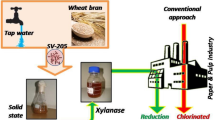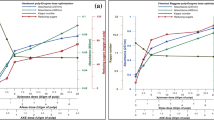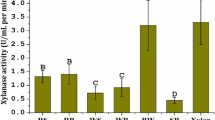Abstract
Bioprocessing of pulp requires lignolytic as well as hemicellulolytic enzymes. The present study is the first report of a cocktail of laccase (L), xylanase (X), and mannanase (M), from a single bacterium for pulp biobleaching. A novel strain Bacillus tequilensis LXM 55 produced thermo-alkali stable L + X + M. On optimization higher enzyme yield (IUml−1/fold increase) of laccase (396.35/24.16), xylanase (212.95/81.90) and mannanase (153.33/102.90) were achieved in the cocktail. Treatment of pulp with cocktail of enzymes led to 49.35% reduction in kappa number and considerable enhancement in the brightness (11.59%), whiteness (4.11%), and other pulp properties. Most importantly, no mediator system was required for the application of laccase. 40% less chlorine consumption was required to obtain the paper of the same quality as that of pulp treated without enzyme but with 100% chlorine. Therefore, this cocktail of enzymes is highly suitable for pulp biobleaching in the paper mill.




Similar content being viewed by others
References
Battan B, Sharma J, Dhiman SS, Kuhad RC (2007) Enhanced production of cellulose free thermostable xylanase by Bacillus pumilus ASH and its potential application in paper industry. Enzyme Microb Technol 41:733–739. https://doi.org/10.1016/j.enzmictec.2007.06.006
Chauhan PS, Soni SK, Sharma P, Saini A, Gupta N (2014) A Mannanase from Bacillus nealsonii PN-11: Statistical optimization of production and Application in Biobleaching of pulp in combination with xylanase. Int J Pharm Bio Sci 5:237–251
Singh G, Ahuja N, Batish M, Capalash N, Sharma P (2008) Biobleaching of wheat straw-rich soda pulp with alkalophilic laccase from Ɣ-proteobacterium JB: Optimization of process parameters using response surface methodology. Bioresour Technol 99:7472–7479. https://doi.org/10.1016/j.biortech.2008.02.023
Sondhi S, Sharma P, Saini S, Puri N, Gupta N (2014) Purification and Characterization of an extracellular thermo-alkali-stable, metal tolerant laccase from Bacillus tequilensis SN4. PLoS ONE 9:e96951. https://doi.org/10.1371/journal.pone.0096951
Janveja C, Rana SS, Soni SK (2013) Kitchen waste residues as potential renewable biomass resources for the production of multiple fungal carbohydrases and second generation. J Technol Innov Renew Energy 2:186–200
Kiddinamoorthy J, Anceno AJ, Haki GD, Rakshit SK (2008) Production, purification and characterization of Bacillus sp. GRE7 xylanase and its application in eucalyptus Kraft pulp biobleaching. World J Microbiol Biotechnol 24:605–612. https://doi.org/10.1007/s11274-007-9516-2
Kamble RD, Jadhav AR (2012) Isolation, purification, and characterization of xylanase produced by a new species of Bacillus in solid state fermentation. Int J Microbiol 2012:683193. https://doi.org/10.1155/2012/683193
Kumar D, Angural S, Rana M, Kaur G, Puri N, Gupta N (2017) Cloning, characterization and its potential in pulp bio bleaching by alkali thermostable β-mannanase from Bacillus sp. 22. Eur J Pharm Med Res 4:584–592
Bajpai P, Anand A, Sharma N, Mishra SP, Bajpai PK, Lachenal D (2006) Enzymes improve ECF bleaching of pulp. Bioresources 1:34–44
Singh G, Capalash N, Goel R, Sharma P (2007) A pH-stable laccase from alkali-tolerant γ-proteobacterium JB: purification, characterization and indigo carmine degradation. Enzyme Microb Technol 41:794–799. https://doi.org/10.1016/j.enzmictec.2007.07.001
Gupta V, Garg S, Capalash N, Gupta N, Sharma P (2015) Production of thermo-alkali-stable laccase and xylanase by co-culturing of Bacillus sp. and B. halodurans for biobleaching of kraft pulp and deinking of waste paper. Bioprocess Biosyst Eng 38:947–956. https://doi.org/10.1007/s00449-014-1340-0
Woldesenbet F, Virk AP, Gupta N, Sharma P (2017) Biobleaching of mixed wood kraft pulp with alkalophilic bacterial xylanase, mannanase and laccase-mediator system. J Microbiol Biotechn Res 3:32–41
Valls C, Roncero MB (2009) Using both xylanase and laccase enzymes for pulp bleaching. Bioresour Technol 100:2032–2039. https://doi.org/10.1016/j.biortech.2008.10.009
Kaur A, Mahajan R, Singh A, Garg G, Sharma J (2010) Application of cellulose-free xylano-pectinolytic enzymes from the same bacterial isolate in biobleaching of kraft pulp. Bioresour Technol 101:9150–9155. https://doi.org/10.1016/j.biortech.2010.07.020
Ravikumar G, Gomathi D, Kalaiselvi M, Uma C (2012) Production, purification and partial characterization of laccase from the mushroom Hypsizygus ulmarius. Int J Pharm Bio Sci 3:355–365
Sharma A, Thakur VV, Shrivastava A, Jain RK, Mathur RM, Gupta R, Kuhad RC (2014) Xylanase and laccase based enzymatic kraft pulp bleaching reduces adsorbable organic halogen (AOX) in bleach effluents: a pilot scale study. Bioresour Technol 169:96–102. https://doi.org/10.1016/j.biortech.2014.06.066
Valls C, Vidal T, Roncero MB (2010) Boosting the effect of a laccase-mediator system by using a xylanase stage in pulp bleaching. J Hazard Mater 177:586–592. https://doi.org/10.1016/j.jhazmat.2009.12.073
Kumar D, Kumar A, Sondhi S, Sharma P, Gupta N (2018) An alkaline bacterial laccase for polymerization of natural precursors for hair dye synthesis. 3 Biotech 8:182. https://doi.org/10.1007/s13205-018-1181-7
Kansoh AL, Nagieb ZA (2004) Xylanase and Mannanase enzymes from Streptomyces galbus NR and their use in biobleaching of softwood kraft pulp. Antonie Van Leeuwenhoek 85:103–114. https://doi.org/10.1023/B:ANTO.0000020281.73208.62
Angural S, Rana M, Sharma A, Warmoota R, Puri N, Gupta N (2020) Combinatorial biobleaching of mixedwood pulp with lignolytic and hemicellulolytic enzymes for paper making. Indian J Microbiol. https://doi.org/10.1007/s12088-020-00867-6
Woldesenbet F, Virk AP, Gupta N, Sharma P (2012) Effect of microwave irradiation on xylanase production from wheat bran and biobleaching of eucalyptus kraft pulp. Appl Biochem Biotech 167:100–108. https://doi.org/10.1007/s12010-012-9663-2
Khusro A, Kaliyan BK, Al-Dhabi NA, Arasu MV, Agastian P (2016) Statistical optimization of thermo-alkali stable xylanase production from Bacillus tequilensis strain ARMATI. Electron J Biotechn 22:16–25. https://doi.org/10.1016/j.ejbt.2016.04.002
Holt JG, Krieg NR, Sneath PHA, Staley JT, Williams ST (1994) Bergey’s manual of determinative bacteriology. Williams and Wilkins, Baltimore
Virk AP, Sharma P, Capalash N (2012) Use of laccase in pulp and paper Industry. Biotechnol Prog 28:21–32. https://doi.org/10.1002/btpr.727
Gubitz GM, Haltrich D, Latal B, Steiner W (1997) Mode of depolymerisation of hemicelluloses by various mannanases and xylanases in relation to their ability to bleach softwood pulp. Appl Microbiol Biotechnol 47:658–662. https://doi.org/10.1007/s002530050991
Gupta V, Capalash N, Gupta N, Sharma P (2016) Bio-prospecting laccases in the bacterial diversity of a activated sludge from pulp and paper industry. Indian J Microbiol 1–8: https://doi.org/10.1007/s12088-016-0624-2
Dhakar K, Pandey A (2013) Laccase production from a temperature and pH tolerant fungal strain of Trametes hirsuta (MTCC 11397). Enzyme Res 2013:869062. https://doi.org/10.1155/2013/869062
Birhanli E, Yesilada O (2017) The effect of various inducers and their combinations with copper on laccase production of Trametes versicolor pellets in a repeated-batch process. Turk J Biol 41:587–599. https://doi.org/10.3906/biy-1608-44
Singh G, Kaur K, Puri S (2015) Critical factors affecting laccase-mediated biobleaching of pulp in paper industry. Appl Microbiol Biotechnol 99:155–164. https://doi.org/10.1007/s00253-014-6219-0
Walia A, Guleria S, Mehta P, Chauhan A, Parkash J (2017) Microbial xylanases and their industrial application in pulp and paper biobleaching: a review. 3 Biotech 7:11. https://doi.org/10.1007/s13205-016-0584-6
Harnpicharnchai P, Pinngoen W, Teanngam W, Sornlake W, Sae-Tang K, Manitchotpisit P, Tanapongpipat S (2016) Production of high activity Aspergillus niger BCC4525 β-mannanase in Pichia pastoris and its application for mannooligosaccharides production from biomass hydrolysis. Biosci biotech bioch 80:2298–2305. https://doi.org/10.1080/09168451.2016.1230003
Khanongnuch C, Asada K, Tsurga H, Ooi T, Kinoshita S, Lumyong S (1998) ß-Mannanase and Xylanase of Bacillus subtilis 5H active for bleaching of crude pulp. J Ferment Bioeng 86:461–466. https://doi.org/10.1016/S0922-338X(98)80152-9
Arias ME, Arenas M, Rodriguez J, Soliveri J, Ball AS, Hernandez M (2003) Kraft pulp Biobleaching and Mediated oxidation of a nonphenolic substrate by Laccase from Streptomyces cyaneus CECT 3335. Appl Environ Microbiol 69:1953–1958. https://doi.org/10.1128/AEM.69.4.1953-1958.2003
Fillat U, Roncero MB (2009) Biobleaching of high quality pulps with laccase-mediator system: Influence of treatment time and oxygen supply. Biochem Eng J 44:193–198. https://doi.org/10.1016/j.bej.2008.12.002
Acknowledgements
The financial support provided by University Grant Commission (UGC-MRP-43-476/2014/SR) and (UGC-SAP II-DRS-I) New Delhi, India is acknowledged.
Author information
Authors and Affiliations
Corresponding author
Ethics declarations
Conflict of interest
The authors declare that they have no conflict of interest.
Additional information
Publisher's Note
Springer Nature remains neutral with regard to jurisdictional claims in published maps and institutional affiliations.
Electronic supplementary material
Below is the link to the electronic supplementary material.
Rights and permissions
About this article
Cite this article
Angural, S., Kumar, A., Kumar, D. et al. Lignolytic and hemicellulolytic enzyme cocktail production from Bacillus tequilensis LXM 55 and its application in pulp biobleaching. Bioprocess Biosyst Eng 43, 2219–2229 (2020). https://doi.org/10.1007/s00449-020-02407-4
Received:
Accepted:
Published:
Issue Date:
DOI: https://doi.org/10.1007/s00449-020-02407-4




